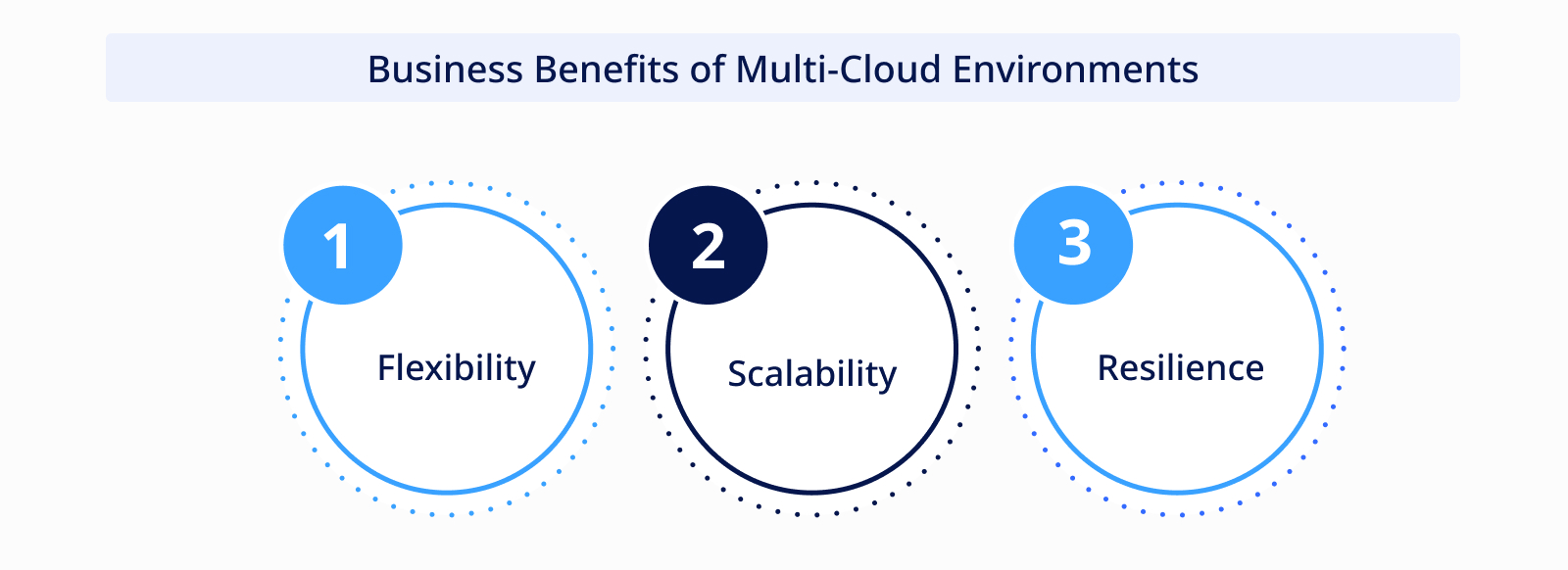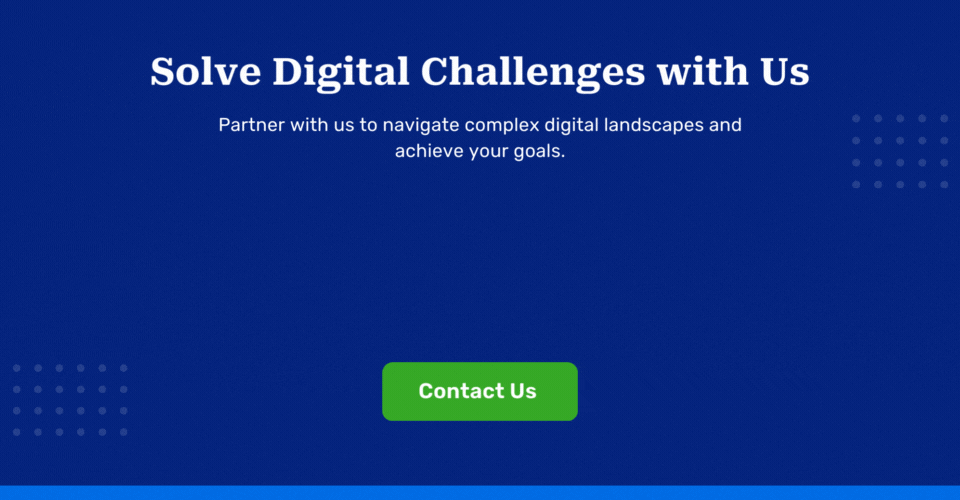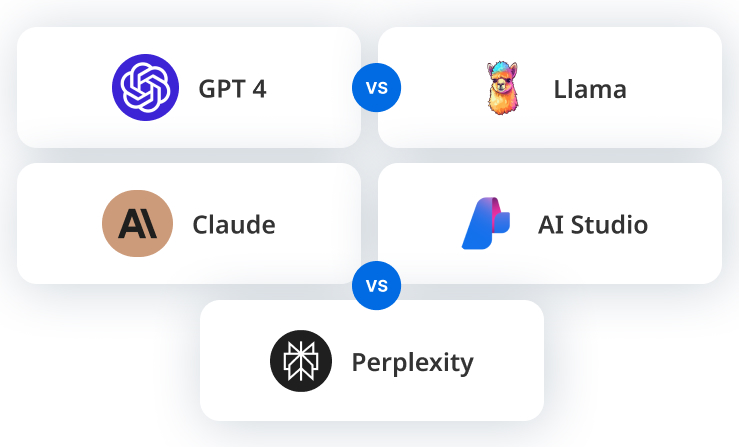Winston Churchill once said, “To improve is to change, so to be perfect is to have changed often.”
Transitioning to a multi-cloud environment is just the beginning of the journey—managing it effectively during the post-migration is where the real challenge lies.
Businesses often struggle with optimizing resource allocation, ensuring data security, and maintaining seamless performance across multiple cloud platforms.
But how can businesses effectively navigate this complexity to boost the benefits of their cloud investments?
This blog revolves around the practical approaches and best practices to help businesses confidently navigate the post-migration landscape.
We cover everything related to multi-cloud migration, from optimizing resource allocation to ensuring data security and compliance.
Table of Contents
Introduction to Multi-Cloud Management
Multi-cloud management involves overseeing and optimizing workloads across multiple cloud platforms like AWS, Azure, and Google Cloud.
Many businesses now prioritize multi-cloud infrastructure for its computing power and resource efficiency.
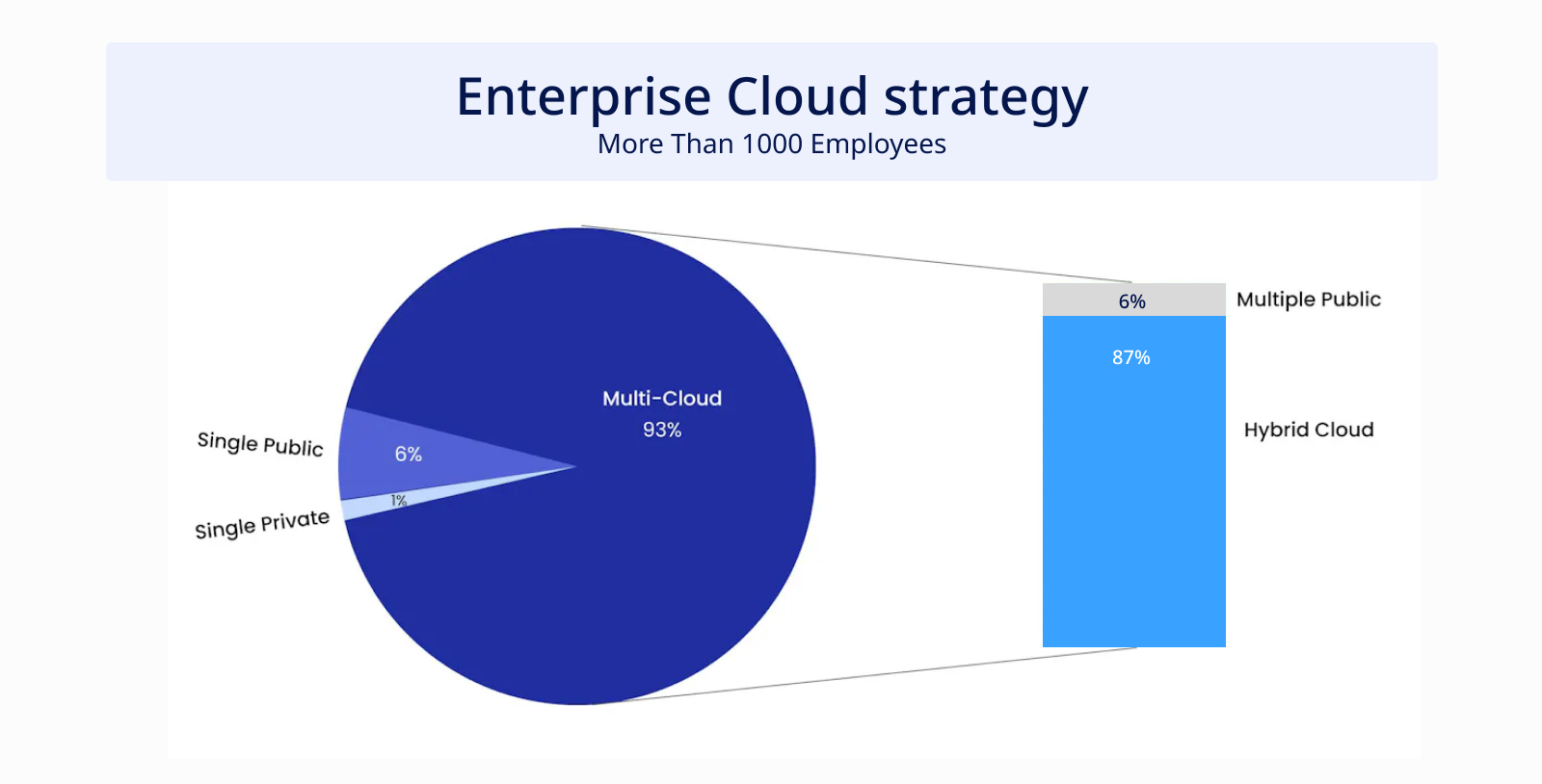
- Diversified risk: Spread your risk across multiple cloud providers, reducing the impact of outages or service disruptions.
- Flexibility and choice: Choose the best services from different providers to meet specific business requirements.
- Avoid vendor lock-in: Maintain flexibility and control over your cloud infrastructure, preventing dependency on a single provider.
Benefits of Multi-Cloud Environments
Now, let’s explore the key benefits of multi-cloud migration:
- Flexibility: With multi-cloud, you’re not tied to a single vendor, allowing you to choose the best services for your needs.
- Scalability: Easily scale your infrastructure up or down based on demand, ensuring optimal performance and cost-efficiency.
- Resilience: Distributed workloads across multiple clouds enhance redundancy and minimize the risk of downtime.
Learn more about the benefits of cloud managed services by visiting our comprehensive blog on the advantages and transformative potential of leveraging cloud managed services for your business.
Post-Migration Management Considerations
Suppose you’ve successfully migrated your applications and data to multiple cloud platforms.
But what comes next?
Managing these diverse environments requires a precise multi-cloud strategy and careful consideration of various factors.
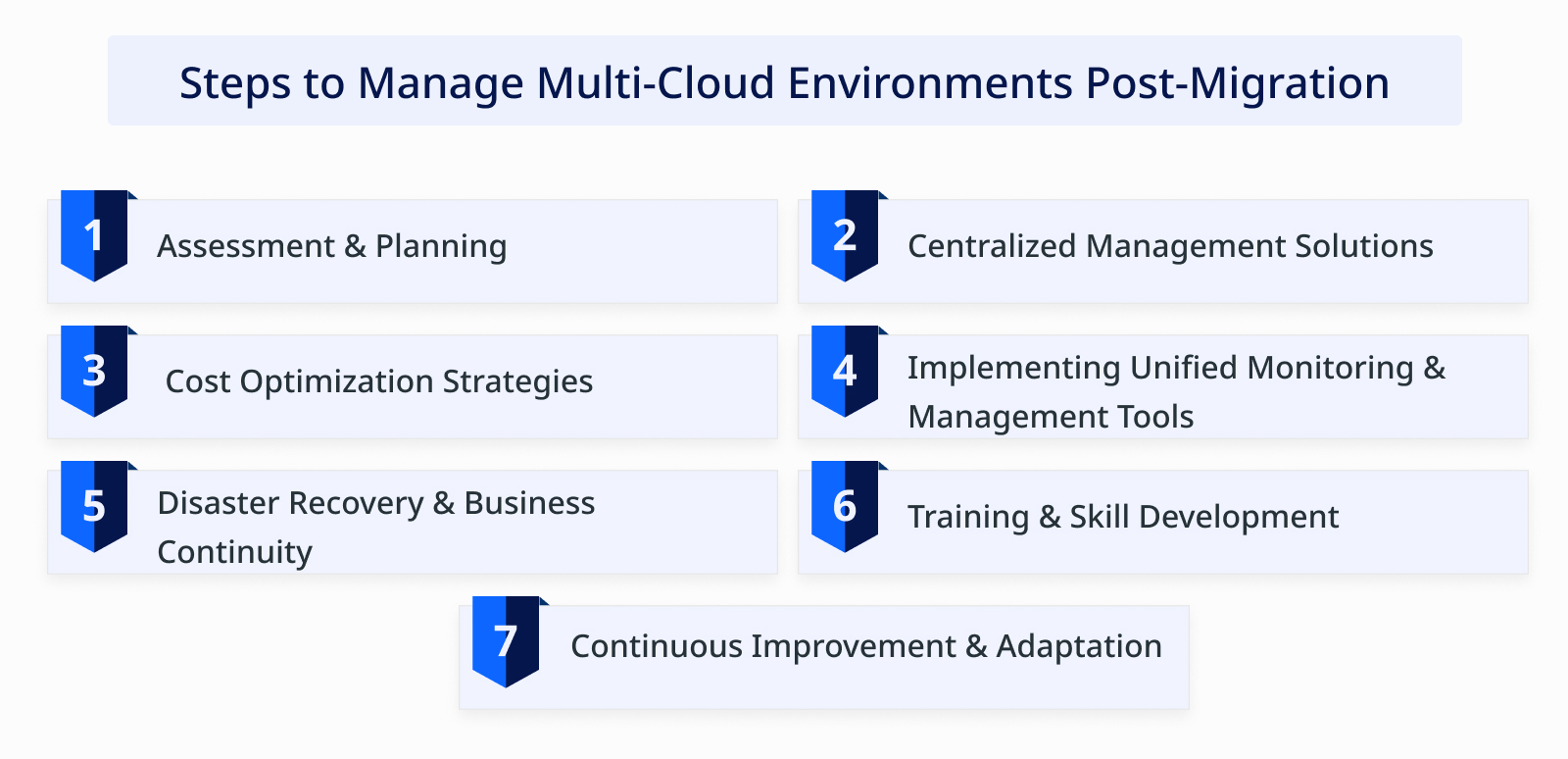
- Assessment and Planning
- Centralized Management Solutions
- Cost Optimization Strategies
- Implementing Unified Monitoring and Management Tools
- Disaster Recovery and Business Continuity
- Training and Skill Development
- Continuous Improvement and Adaptation
Let’s talk about each point in detail…
Assessment & Planning
Once you’ve migrated to a multi-cloud environment, the next step is to assess and plan how to manage your resources and workloads effectively.
Let’s dive into the key considerations for conducting a comprehensive assessment and developing a strategic plan.
1. Conduct a Comprehensive Assessment of the Multi-Cloud Environment
Before diving into management strategies, conducting a thorough assessment of your multi-cloud environment is crucial.
Here’s how:
Evaluate Current Workloads and Applications
- Identify all existing workloads and applications running across different cloud platforms.
- Assess their performance, resource utilization, and dependencies.
Audit Security and Compliance Postures
- Review security configurations and compliance measures across all cloud environments.
- Identify any potential vulnerabilities or non-compliance issues.
Analyze Cost and Resource Utilization
- Analyze cost and resource utilization data to identify inefficiencies and optimize spending.
- Look for opportunities to rightsize instances and optimize resource allocation.
Suppose you’ve migrated your e-commerce application to a multi-cloud environment consisting of AWS and Azure.
During the assessment, you discover that specific components, such as the database server, are heavily utilized on AWS, while Azure is underutilized.
This insight helps you optimize resource allocation and improve cost efficiency.
Let's connect virtually or ask for an estimate of your project.
2. Develop a Strategic Plan for Managing Resources & Workloads
Once you clearly understand your multi-cloud environment, it’s time to develop a strategic plan for managing resources and workloads effectively.
Here’s how to approach it:
Define Management Objectives and Goals
- Define clear objectives and goals for managing your multi-cloud environment.
- Determine key performance indicators (KPIs) to measure success.
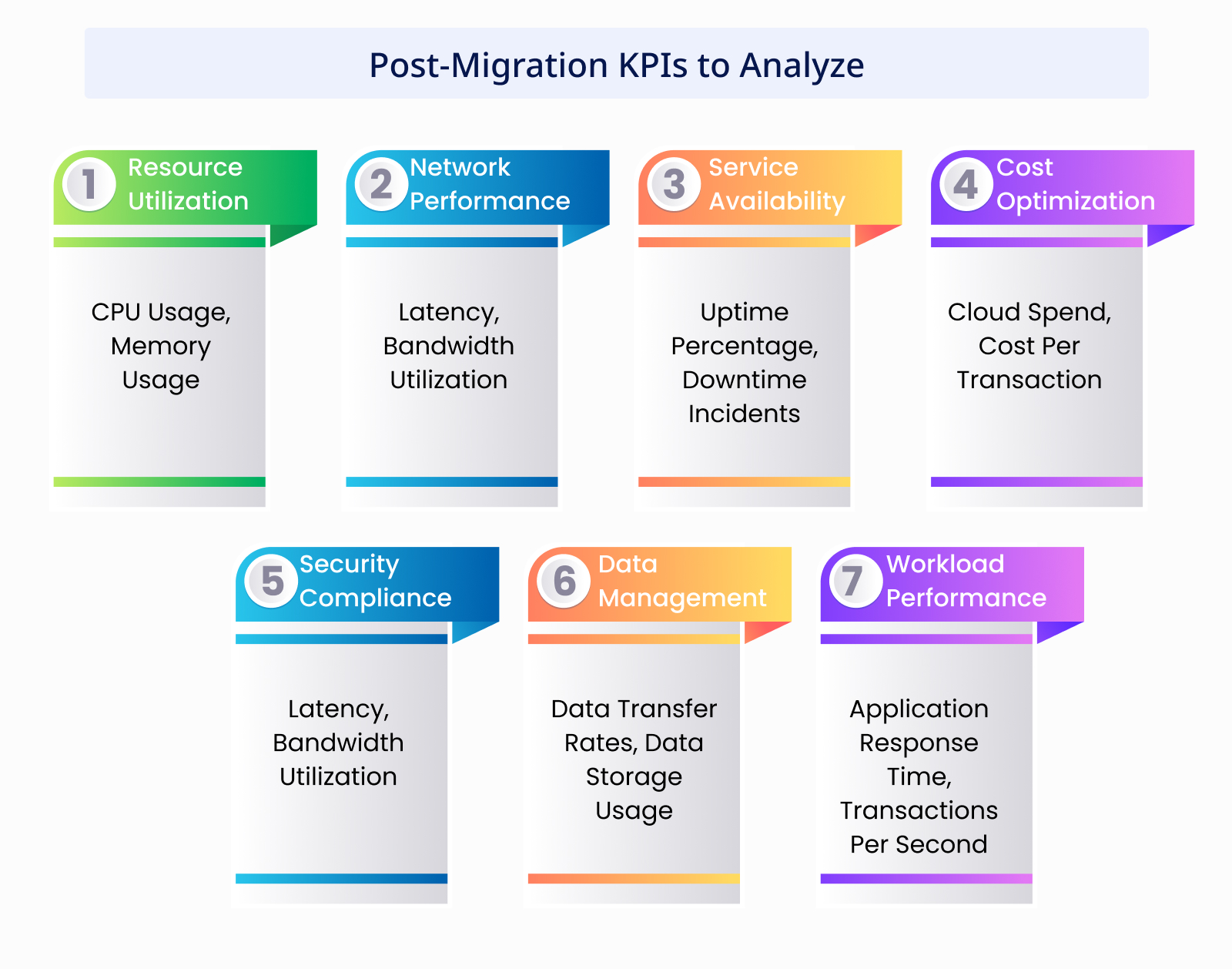
- Establish governance policies and procedures to ensure consistency and compliance across cloud platforms.
- Define roles and responsibilities for managing resources and enforcing policies.
Implement Automation and Orchestration
- Leverage automation tools and orchestration frameworks to streamline management tasks and workflows.
- Automate provisioning, scaling, and monitoring processes to improve efficiency.
Develop Disaster Recovery and Business Continuity Plans
- Build comprehensive disaster recovery and business continuity plans to mitigate risks and ensure resilience.
- Test and validate recovery procedures regularly to minimize downtime and data loss.
Suppose your organization’s primary objective is to optimize costs while maintaining high availability for critical workloads.
In your strategic plan, you prioritize rightsizing instances, leveraging reserved instances or savings plans, and implementing automated scaling policies to meet fluctuating demand efficiently.
Centralized Management Solutions
Managing multi-cloud environments post-migration requires robust tools and platforms for centralized management.
Let’s explore solutions to achieve visibility, control, and automation across your multi-cloud infrastructure.
1. Exploring Tools and Platforms for Centralized Management
Several tools and platforms offer comprehensive multi-cloud solutions when it comes to centralized management of multi-cloud environments.
Here are some options to consider during Google cloud migration:
Cloud Management Platforms (CMPs)
CMPs like CloudHealth, Azure Arc, and Google Cloud Anthos provide centralized visibility and management across multiple cloud platforms. They offer features such as cost optimization, governance, and security.
Cloud Orchestration Tools
Tools like Terraform and AWS CloudFormation enable infrastructure as code (IaC) to automate provisioning, configuration, and deployment of resources across different cloud providers.
Cloud Service Brokers
Brokers like RightScale and Morpheus act as intermediaries between cloud consumers and providers, offering a unified interface for managing and accessing cloud services.
2. Implementing Solutions for Visibility, Control & Automation
Achieving visibility, control, and automation is essential for effectively managing multi-cloud environments.
Here’s how to implement solutions to address these needs:
Visibility
Utilize monitoring and analytics tools like Datadog, New Relic, or Azure Monitor to gain insights into your multi-cloud resources’ performance, health, and utilization.
Control
Implement policy-driven governance frameworks using tools like AWS Organizations, Azure Policy, or Google Cloud IAM to enforce compliance, security, and cost management across your cloud environment.
Automation
Embrace automation through DevOps practices and tools like Jenkins, GitLab CI/CD, or Azure DevOps to streamline deployment pipelines, infrastructure provisioning, and configuration management.
Cost Optimization Strategies
Managing costs in a multi-cloud environment post-migration is crucial for maximizing ROI.
Let’s explore some cost optimization strategies:
1. Identifying Cost-saving Opportunities & Optimizing Cloud Spend
Businesses must maximize ROI and ensure efficient resource allocation in multi-cloud environments post-migration.
- Conduct regular audits to identify unused resources and eliminate them to reduce costs.
- Utilize the cloud provider’s cost management tools to monitor spending and identify areas for optimization.
- Implement automated scaling to adjust resource allocation based on demand, reducing unnecessary expenses.
- Optimize storage costs by archiving or deleting unused data and leveraging tiered storage options for cost-effective data management.
2. Implementing Strategies for Resource Allocation & Usage Tracking
The implementation of strategies prevents over-provisioning, minimizes resource waste, and achieves optimal performance in multi-cloud environments post-migration.
- Establish budget allocation and monitoring mechanisms to track spending against predefined budgets.
- Utilize tagging and labeling to categorize resources and track costs by project, department, or team.
- Implement cost allocation and chargeback mechanisms to hold teams accountable for cloud usage.
- Regularly review and optimize Reserved Instances (RIs) and Savings Plans to maximize cost savings while ensuring optimal resource utilization.
Are you ready to harness the power of cloud for digital transformation? Explore our blog to discover how leveraging cloud technologies can drive innovation and propel your business forward.
Let's connect virtually or ask for an estimate of your project.
Implementing Unified Monitoring & Management Tools
Managing multi-cloud environments requires robust monitoring and management tools to ensure seamless operations across different cloud platforms.
Let’s explore how to select suitable solutions and integrate them effectively.
1. Selecting Suitable Monitoring & Management Solutions
When choosing monitoring and management solutions for your multi-cloud environment, consider the following factors:
Compatibility
Ensure the tools are compatible with the cloud platforms you’re using, such as AWS, Azure, and Google Cloud.
Scalability
Select tools that can scale with your infrastructure as it grows to accommodate increasing workloads and resources.
Comprehensive Features
Look for solutions that offer a wide range of features, including performance monitoring, resource optimization, and security management.
Cost-Effectiveness
Evaluate the cost of the tools and compare them against their features and benefits to ensure they provide value for money.
User-Friendly Interface
Choose tools with intuitive interfaces that make configuring and managing your multi-cloud environment easy.
2. Integrating Monitoring Tools to Provide Comprehensive Insights Across Clouds
Integrating monitoring tools allows you to gain comprehensive insights into your multi-cloud environment by consolidating data from different cloud platforms.
Here’s how to do it effectively:
Unified Dashboard
- Integrate monitoring tools to create a unified dashboard that provides a consolidated view of your multi-cloud environment.
- Gain insights into performance metrics, resource utilization, and security posture across all clouds.
Cross-Cloud Visibility
- Enable seamless visibility into workloads and applications deployed across different cloud platforms.
- Monitor and manage resources consistently, regardless of the underlying cloud infrastructure.
Alerting & Remediation
- Set up notifications and alerts to proactively identify and address issues across multiple clouds.
- Implement automated remediation actions to mitigate potential risks and ensure continuous operations.
Disaster Recovery & Business Continuity
Disaster recovery and business continuity are essential aspects of managing multi-cloud environments post-migration.
Let’s explore how to develop a comprehensive plan to safeguard your operations.
1. Developing a Comprehensive Disaster Recovery Plan
In the unpredictable world of cloud computing, having a robust disaster recovery plan is essential to mitigate risks and ensure business continuity.
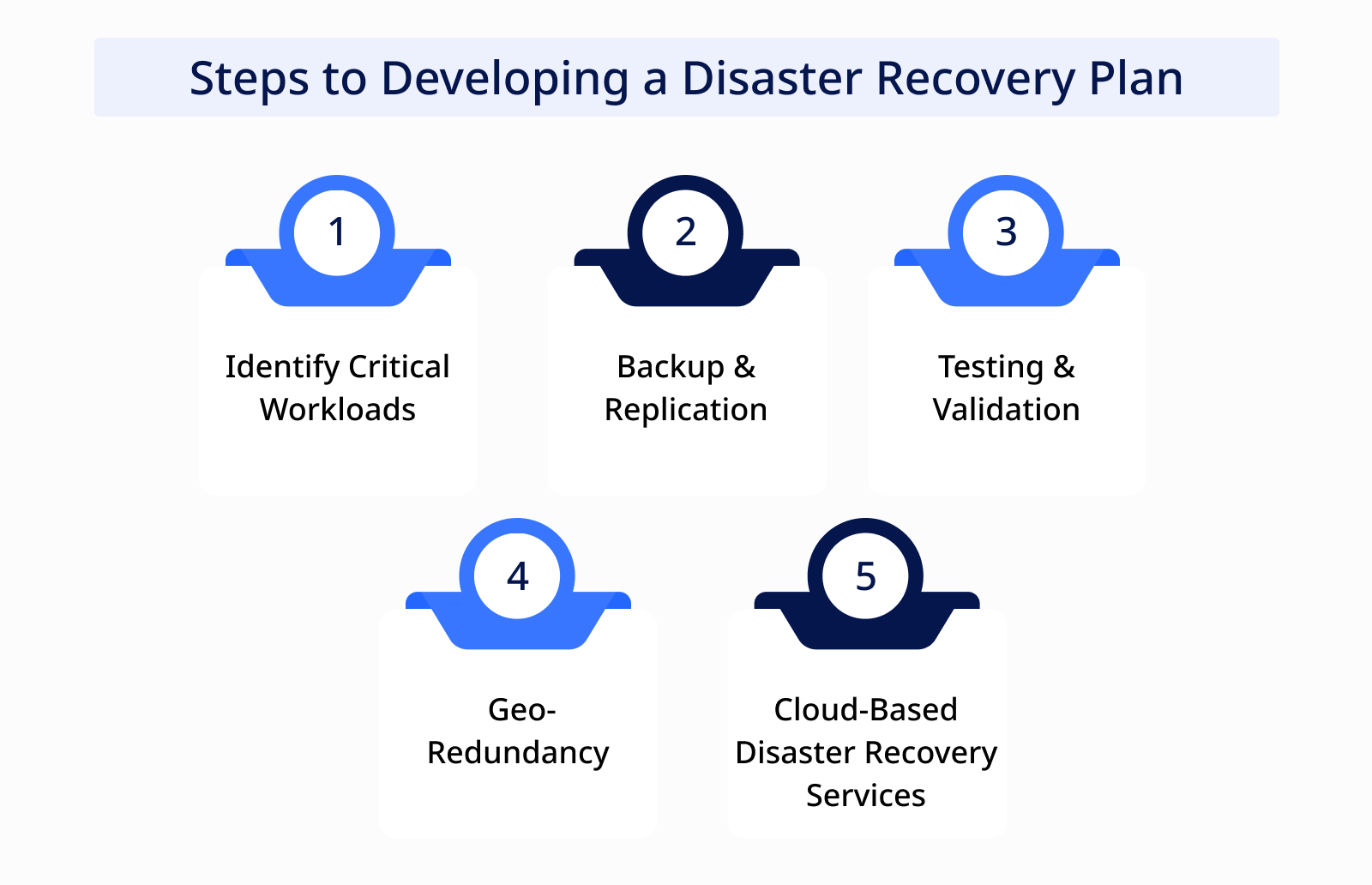
Identify Critical Workloads
Determine which workloads are mission-critical and prioritize them for disaster recovery planning.
Backup and Replication
Implement automated backup and replication strategies across multiple cloud platforms to ensure data redundancy.
Testing and Validation
Regularly test and validate your disaster recovery plan to ensure its effectiveness in real-world scenarios.
Geo-Redundancy
Leverage geo-redundancy by replicating data and applications across different geographical regions to mitigate regional outages.
Cloud-Based Disaster Recovery Services
Explore cloud-based disaster recovery services offered by cloud providers for cost-effective and scalable solutions.
2. Ensuring Business Continuity
Maintaining business continuity during disruptions or outages is crucial to minimize the impact on operations and customer experience.
Here’s how to ensure business continuity in multi-cloud environments:
High Availability Architecture
Design your multi-cloud migration architecture for high availability by distributing workloads across redundant cloud regions.
Failover and Redundancy
Implement failover mechanisms and redundancy strategies to minimize downtime and ensure continuous operations.
Monitoring and Alerting
Deploy monitoring and alerting tools to detect and respond to potential issues before they escalate proactively.
Automated Recovery Processes
Automate recovery processes to streamline the restoration of services and minimize manual intervention.
Disaster Recovery Drills
Conduct regular disaster recovery drills to train your team and validate the effectiveness of your business continuity measures.
Also Read – Cloud Adoption: How To Accelerate
Training & Skill Development
Investing in training programs and skill development initiatives is crucial to ensure your teams are equipped with the necessary expertise.
Let’s explore how you can effectively empower your teams to manage multi-cloud environments post-migration.
1. Investing in Training Programs & Skill Development Initiatives
It is crucial for empowering your teams with the knowledge and capabilities required to navigate the complexities of multi-cloud environments.
Why Invest in Training?
- Enhance team capabilities: Equip your teams with the knowledge and skills to navigate complex multi-cloud environments confidently.
- Stay ahead of trends: Keep abreast of the latest developments and best practices in cloud technology to maintain a competitive edge.
What Training Programs to Consider?
- Vendor-specific certifications: Obtain certifications from leading cloud providers like AWS, Azure, and Google Cloud to validate expertise in their respective platforms.
- Multi-cloud training courses: Enroll your teams in multi-cloud training programs that cover various cloud platforms and their interoperability.
How to Implement Training Initiatives?
- Identify skill gaps: Conduct assessments to identify areas where your teams require additional training or development.
- Tailor training plans: Develop customized training plans tailored to your organization’s needs and objectives.
- Provide hands-on experience: Offer practical training opportunities to reinforce theoretical knowledge and enhance practical skills.
2. Equipping Teams with the Necessary Expertise
Equipping your teams with the necessary expertise requires a strategic approach and ongoing commitment to skill development.
What Expertise is Required?
- Cloud architecture and design: Develop expertise in designing scalable, resilient, and secure cloud architectures across multiple platforms.
- Cloud security and compliance: Ensure teams are well-versed in implementing robust security measures and maintaining compliance in multi-cloud environments.
How to Foster Expertise Development?
- Encourage continuous learning: Foster a culture of constant learning and professional development within your organization.
- Resources and support: Offer access to online courses, learning materials, and mentorship programs to support skill development.
- Foster collaboration: Encourage collaboration and knowledge-sharing among team members to facilitate mutual learning and growth.
Continuous Improvement & Adaptation
Continuous improvement and adaptation are crucial for businesses to staying ahead of the curve.
Let’s explore the significance of these practices and how to implement them effectively.
1. Emphasizing the Importance of Continuous Improvement & Adaptation
Continuous improvement isn’t just a buzzword—it’s necessary to thrive in dynamic multi-cloud environments.
Here’s why it’s crucial:
Why is Continuous Improvement Important?
- Agility: Adapt quickly to changing business needs and market trends.
- Efficiency: Identify and eliminate inefficiencies to optimize resource utilization.
- Innovation: Foster innovation by embracing new technologies and best practices.
- Resilience: Build resilience against disruptions by continuously enhancing your infrastructure and processes.
2. Implementing Feedback Loops & Agile Practices for Ongoing Optimization
Feedback loops and agile practices are key drivers of continuous improvement in multi-cloud management:
Gathering Feedback
- Solicit feedback from stakeholders, end-users, and IT teams to understand pain points and areas for improvement.
- Conducting regular surveys or feedback sessions to gather user experience and performance insights.
Iterative Development
- Embrace agile methodologies like Scrum or Kanban to develop and enhance your multi-cloud infrastructure iteratively.
- Breaking down projects into smaller, manageable tasks and delivering incremental updates based on user feedback.
Monitoring & Analysis
- Continuously monitor performance metrics, cost trends, and security incidents to identify areas needing optimization.
- Setting up monitoring tools to track resource utilization, latency, and error rates across cloud platforms.
Adaptive Decision-Making
- Make data-driven decisions based on real-time insights and feedback, adjusting strategies to achieve desired outcomes.
- Scaling resources up or down based on fluctuating demand patterns to optimize cost and performance.
Are you considering adopting cloud technology? Check out our latest blog post for expert insights and tips on making the transition seamlessly.
Let's connect virtually or ask for an estimate of your project.
Key Takeaways
Effectively managing multi-cloud environments post-migration requires ongoing attention to optimization, security, and performance.
By implementing the right approaches and best practices, businesses can maximize the benefits of cloud services while mitigating risks and challenges. Continuous improvement, feedback loops, and agile practices are essential for maintaining efficiency and adaptability in dynamic cloud environments.
To ensure seamless management and capitalize on the benefits of cloud managed services, consider partnering with a trusted provider like PixelCrayons. Our expertise in cloud services can help streamline operations, enhance security, and drive business growth. a
Contact us today to know more about how we can support your multi-cloud management needs.

